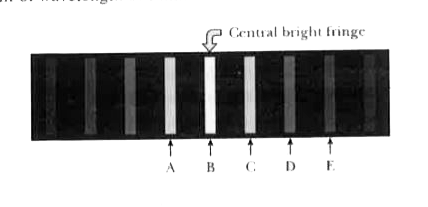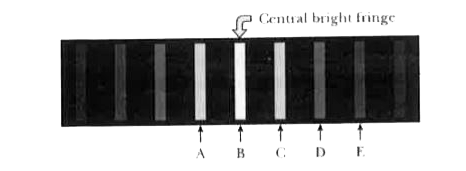_E01_082_Q01.png)
The figure shows the interfernece pattern obtained in double slit experiment using light of wavelength 600 nm.
Q. Let ΔXA and ΔXC represent path differences between waves interering at 1 and 3 respectively then (|ΔXC|−(|ΔXA|) is equal to
0
300 mn
600 nm
900 nm
The correct Answer is:B
CBF⇒ path difference =0
ΔXA→At 1
dark fringe having path difference =λ2
ΔXC→At 3,
bright fringes path difference =λ
∴(|ΔXC|−|ΔXA|)=(λ−λ2)=λ2=6002nm=300nm
Topper's Solved these Questions
- WAVE OPTICSBook:ALLENChapter:WAVE OPTICSExercise:Exercise 4 A (Conceptual subjective Exercise)
Explore 9 Videos
- WAVE OPTICSBook:ALLENChapter:WAVE OPTICSExercise:Exercise 4 B (Conceptual subjective Exercise)
Explore 8 Videos
- WAVE OPTICSBook:ALLENChapter:WAVE OPTICSExercise:Exercise 2 (Brain Teasures)
Explore 22 Videos
- UNIT & DIMENSIONS, BASIC MATHS AND VECTOR Book:ALLENChapter:UNIT & DIMENSIONS, BASIC MATHS AND VECTOR Exercise:Exercise (J-A)
Explore 7 Videos
Similar Questions
In double slit experiment using light of wavelength 600nm, the angular width of a fringe formed on a distant screen is 0.1∘. What is the spacing between the two slits ?
View SolutionIn double slit experiment using light of wavelength 600nm, the angular width of a fringe formed on a distant screen is 0.1∘. What is the spacing between the two slits ?
View Solution
Knowledge Check
_E01_080_Q01.png)
The figure shows the interfernece pattern obtained in double slit experiment using light of wavelength 600 nm.
Q. The third order bright fringe isA2B3C4D5The figure shows the interference pattern obtained in a double-slit experiment using light of wavelength 600 nm.

Which fringe results from a phase difference of 4π?AABCCBDD_E01_081_Q01.png)
The figure shows the interfernece pattern obtained in double slit experiment using light of wavelength 600 nm.
Q. Which fringe results from a phase difference of 4π between the light waves incidenting from two slits?A2B3C4D5
In double-slit Experiment using light of wavelength 600 nm, the angular width of a fringe formed on a distance screen is 0.1∘. What is the spacing between the two slits?
View SolutionThe figure shows the interference pattern obtained in a double-slit experiment using light of wavelength 600 nm.

Which fringe is the same distance from both slits?
View SolutionThe figure shows the interference pattern obtained in a double-slit experiment using light of wavelength 600 nm.

Which fringe is 300 nm closer to one slit than to the other?
View Solution_E01_080_Q01.png)
The figure shows the interfernece pattern obtained in double slit experiment using light of wavelength 600 nm.
Q. The third order bright fringe is
View SolutionIn Young's double slit intefrence experiment the wavelength of light used is 6000Å . If the path difference between waves reaching a point P on the screen is 1.5 microns, then at that point P
View Solution
